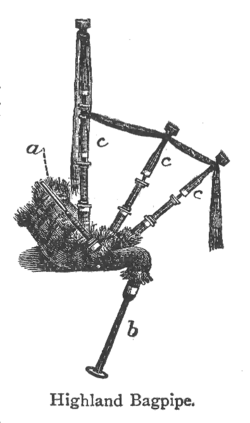Bagpipe theorem
In mathematics, the bagpipe theorem of Peter Nyikos (1984) describes the structure of the connected (but possibly non-paracompact) ω-bounded surfaces by showing that they are "bagpipes": the connected sum of a compact "bag" with several "long pipes".
Statement
A space is called ω-bounded if the closure of every countable set is compact. For example, the long line and the closed long ray are ω-bounded but not compact. When restricted to a metric space ω-boundedness is equivalent to compactness.
The bagpipe theorem states that every ω-bounded connected surface is the connected sum of a compact connected surface and a finite number of long pipes.
A space P is called a long pipe if there exist subspaces [math]\displaystyle{ \{U_\alpha: \alpha \lt \omega_1 \} }[/math] each of which is homeomorphic to [math]\displaystyle{ S^1 \times \mathbb{R} }[/math] such that for [math]\displaystyle{ n\lt m }[/math] we have [math]\displaystyle{ \overline{U_n} \subseteq U_m }[/math] and the boundary of [math]\displaystyle{ U_n }[/math] in [math]\displaystyle{ U_m }[/math] is homeomorphic to [math]\displaystyle{ S^1 }[/math]. The simplest example of a pipe is the product [math]\displaystyle{ S^1 \times L^+ }[/math] of the circle [math]\displaystyle{ S^1 }[/math] and the long closed ray [math]\displaystyle{ L^+ }[/math], which is an increasing union of [math]\displaystyle{ \omega_1 }[/math] copies of the half-open interval [math]\displaystyle{ [0,1) }[/math], pasted together with the lexicographic ordering. Here, [math]\displaystyle{ \omega_1 }[/math] denotes the first uncountable ordinal number, which is the set of all countable ordinals. Another (non-isomorphic) example is given by removing a single point from the "long plane" [math]\displaystyle{ L \times L }[/math] where [math]\displaystyle{ L }[/math] is the long line, formed by gluing together two copies of [math]\displaystyle{ L^+ }[/math] at their endpoints to get a space which is "long at both ends". There are in fact [math]\displaystyle{ 2^{\aleph_1} }[/math] different isomorphism classes of long pipes.
The bagpipe theorem does not describe all surfaces since there are many examples of surfaces that are not ω-bounded, such as the Prüfer manifold.
References
- Nyikos, Peter (1984), "The theory of nonmetrizable manifolds", Handbook of set-theoretic topology, Amsterdam: North-Holland, pp. 633–684
 |


